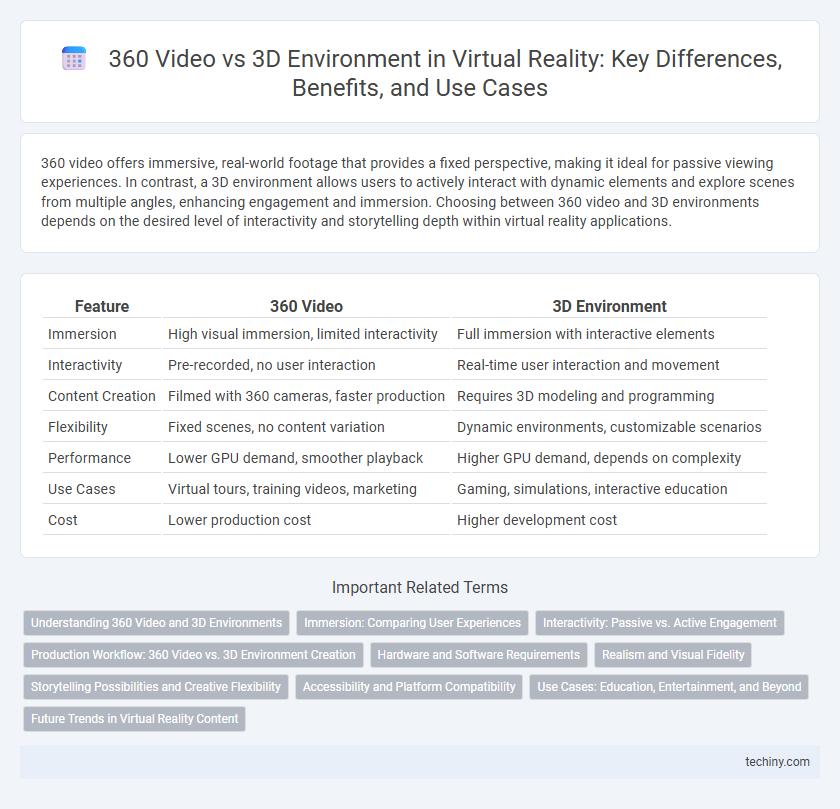360 video offers immersive, real-world footage that provides a fixed perspective, making it ideal for passive viewing experiences. In contrast, a 3D environment allows users to actively interact with dynamic elements and explore scenes from multiple angles, enhancing engagement and immersion. Choosing between 360 video and 3D environments depends on the desired level of interactivity and storytelling depth within virtual reality applications.
Table of Comparison
| Feature | 360 Video | 3D Environment |
|---|---|---|
| Immersion | High visual immersion, limited interactivity | Full immersion with interactive elements |
| Interactivity | Pre-recorded, no user interaction | Real-time user interaction and movement |
| Content Creation | Filmed with 360 cameras, faster production | Requires 3D modeling and programming |
| Flexibility | Fixed scenes, no content variation | Dynamic environments, customizable scenarios |
| Performance | Lower GPU demand, smoother playback | Higher GPU demand, depends on complexity |
| Use Cases | Virtual tours, training videos, marketing | Gaming, simulations, interactive education |
| Cost | Lower production cost | Higher development cost |
Understanding 360 Video and 3D Environments
360 video captures real-world scenes in all directions, providing immersive visual experiences through spherical footage, yet it lacks interactive elements and depth perception. In contrast, 3D environments are computer-generated spaces allowing users to navigate, manipulate objects, and experience dynamic interactions with virtual elements. Understanding the differences between 360 video's passive viewing and 3D environments' active engagement is key to selecting the appropriate VR content for training, entertainment, or simulation purposes.
Immersion: Comparing User Experiences
360 video offers a realistic, pre-recorded environment that provides users with a panoramic view, enhancing immersion through high-quality visuals but limiting interaction within the experience. In contrast, a 3D environment enables dynamic user interaction and navigation, allowing for greater agency and personalized exploration that deepens the sense of presence in virtual reality. Immersion in 3D environments is further amplified by real-time rendering and responsive elements, which adapt to user inputs unlike static 360 videos.
Interactivity: Passive vs. Active Engagement
360 video offers passive engagement by allowing viewers to look around immersive scenes but limits interaction to predetermined perspectives. In contrast, 3D environments enable active engagement where users can freely navigate, manipulate objects, and influence the virtual world in real time. This interactivity significantly enhances user immersion and tailored experiences in virtual reality applications.
Production Workflow: 360 Video vs. 3D Environment Creation
360 video production involves capturing real-world footage using specialized cameras, followed by stitching and color correction to create an immersive spherical view, which requires less intensive modeling or animation. In contrast, 3D environment creation demands detailed asset modeling, texturing, lighting, and real-time rendering, offering higher interactivity but with longer development cycles and advanced software expertise. Choosing between 360 video and 3D environments depends on factors like desired user interaction, production timeline, and resource availability.
Hardware and Software Requirements
360 video requires less demanding hardware and simpler software, playable on standard VR headsets and mobile devices with basic GPU capabilities. In contrast, 3D environments necessitate advanced GPUs, more RAM, and powerful processors to render interactive, real-time graphics, supported by sophisticated game engines like Unity or Unreal Engine. Software development for 3D environments is more complex, involving spatial computing, physics simulation, and dynamic user interaction elements.
Realism and Visual Fidelity
360 video offers high realism by capturing real-world scenes in full panoramic detail, providing authentic visual fidelity through actual footage. However, 3D environments excel in interactivity and dynamic lighting, allowing for adjustable perspectives and immersive depth that enhance realism beyond static video. Advances in real-time rendering and shading techniques continually improve 3D visual fidelity, narrowing the gap with the photographic accuracy of 360 videos.
Storytelling Possibilities and Creative Flexibility
360 video offers immersive storytelling by capturing real-world scenes with dynamic perspectives, enabling viewers to explore narrative environments visually. In contrast, 3D environments provide greater creative flexibility with fully customizable settings, interactive elements, and character animations that enhance engagement and adaptability in storytelling. The choice between 360 video and 3D environments depends on the desired blend of realism and interactivity to maximize narrative impact in virtual reality experiences.
Accessibility and Platform Compatibility
360 video offers broader accessibility, enabling users to experience immersive content on various devices, including smartphones, tablets, and standard web browsers without the need for specialized hardware. In contrast, 3D environments typically require more advanced VR headsets and higher processing power, limiting platform compatibility and user reach. This makes 360 video an ideal choice for delivering immersive experiences to a wider audience across diverse platforms.
Use Cases: Education, Entertainment, and Beyond
360 video offers an immersive but passive experience ideal for education and entertainment sectors, providing realistic visual storytelling and virtual field trips without interactive elements. In contrast, 3D environments deliver active engagement through user interaction and dynamic content, making them suitable for complex training simulations, gaming, and virtual collaboration. Both technologies expand the scope of virtual reality, catering to diverse applications from immersive lectures to interactive entertainment and professional development.
Future Trends in Virtual Reality Content
360 video offers immersive, real-world captures that are increasingly integrated with AI-driven interactivity to enhance viewer engagement. 3D environments provide customizable, dynamic experiences fueled by advancements in real-time rendering and spatial audio technologies. Future trends in virtual reality content prioritize hybrid models that combine photorealistic 360 video with interactive 3D elements to create seamless, multisensory user experiences.
360 video vs 3D environment Infographic

 techiny.com
techiny.com